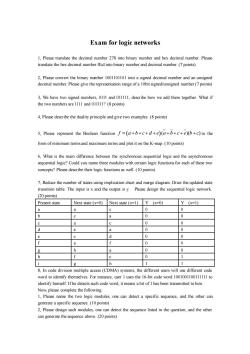同济大学:《逻辑网络》课程教学资源(试卷习题)考试样卷

Exam for logic networks 1,Please translate the decimal number 278 into binary number and hex decimal number.Please translate the hex decimal number ffcd into binary number and decimal number.(7 points) 2,Please convert the binary number 1001101101 into a signed decimal number and an unsigned decimal number.Please give the representation range of a 10bit signed/unsigned number(7 points) 3,We have two signed numbers,0111 and 011111,describe how we add them together.What if the two numbers are 1111 and 011111?(8 points) 4,Please describe the duality principle and give two examples.(8 points) 5,Please represent the Boolean function f=(a+b+c+d+e)(a+b+c+e)(b+c)in the form of minimum terms and maximum terms and plot it on the K-map.(10 points) 6,What is the main difference between the synchronous sequential logic and the asynchronous sequential logic?Could you name three modules with certain logic functions for each of these two concepts?Please describe their logic functions as well.(10 points) 7,Reduce the number of states using implication chart and merge diagram.Draw the updated state transition table.The input is x and the output is y.Please design the sequential logic network. (20 points) Present state Next state (x=0) Next state (x=1) Y (x=0) Y (x=1) a a 0 0 b c 0 0 c a c 0 0 d e a 0 0 e c d 0 0 f 8 f 0 0 g h a 0 0 h f 0 1 h 1 1 8,In code division multiple access(CDMA)systems,the different users will use different code word to identify themselves.For instance,user 1 uses the 16-bit code word 1001001100111111 to identify himself.If he detects such code word.it means a bit of 1 has been transmitted to him Now,please complete the following: 1,Please name the two logic modules,one can detect a specific sequence,and the other can generate a specific sequence.(10 points) 2,Please design such modules,one can detect the sequence listed in the question,and the other can generate the sequence above.(20 points)
Exam for logic networks 1, Please translate the decimal number 278 into binary number and hex decimal number. Please translate the hex decimal number ffcd into binary number and decimal number. (7 points) 2, Please convert the binary number 1001101101 into a signed decimal number and an unsigned decimal number. Please give the representation range of a 10bit signed/unsigned number (7 points) 3, We have two signed numbers, 0111 and 011111, describe how we add them together. What if the two numbers are 1111 and 011111? (8 points) 4, Please describe the duality principle and give two examples. (8 points) 5, Please represent the Boolean function f a b c d e a b c e b c = + + + + + + + + ( )( )( ) in the form of minimum terms and maximum terms and plot it on the K-map. (10 points) 6, What is the main difference between the synchronous sequential logic and the asynchronous sequential logic? Could you name three modules with certain logic functions for each of these two concepts? Please describe their logic functions as well. (10 points) 7, Reduce the number of states using implication chart and merge diagram. Draw the updated state transition table. The input is x and the output is y. Please design the sequential logic network. (20 points) Present state Next state (x=0) Next state (x=1) Y (x=0) Y (x=1) a a c 0 0 b c a 0 0 c a c 0 0 d e a 0 0 e c d 0 0 f a f 0 0 g h a 0 0 h f c 0 1 i g h 1 1 8, In code division multiple access (CDMA) systems, the different users will use different code word to identify themselves. For instance, user 1 uses the 16-bit code word 1001001100111111 to identify himself. If he detects such code word, it means a bit of 1 has been transmitted to him. Now, please complete the following: 1, Please name the two logic modules, one can detect a specific sequence, and the other can generate a specific sequence. (10 points) 2, Please design such modules, one can detect the sequence listed in the question, and the other can generate the sequence above. (20 points)
按次数下载不扣除下载券;
注册用户24小时内重复下载只扣除一次;
顺序:VIP每日次数-->可用次数-->下载券;
- 同济大学:《逻辑网络》课程教学资源(教学大纲)逻辑网络(英文)Logic networks.doc
- 同济大学:《逻辑网络》课程教学资源(教学大纲)逻辑网络(中文,负责人:周俊鹤).doc
- 北京化工大学:《数据结构》课程PPT教学课件(C语言描述)第六章 查找.ppt
- 北京化工大学:《数据结构》课程PPT教学课件(C语言描述)第五章 图.ppt
- 北京化工大学:《数据结构》课程PPT教学课件(C语言描述)第三章 栈和队列.ppt
- 北京化工大学:《数据结构》课程PPT教学课件(C语言描述)第二章 线性表.ppt
- 北京化工大学:《数据结构》课程PPT教学课件(C语言描述)第一章 绪论(负责人:侯虹).ppt
- 北京化工大学:《大学计算机基础》课程电子教案(PPT教学课件)第7章 多媒体技术基础.ppt
- 北京化工大学:《大学计算机基础》课程电子教案(PPT教学课件)第6章 数据库基础.ppt
- 北京化工大学:《大学计算机基础》课程电子教案(PPT教学课件)第5章 程序设计与软件工程基础.ppt
- 北京化工大学:《大学计算机基础》课程电子教案(PPT教学课件)第4章 计算机网络技术基础.ppt
- 北京化工大学:《大学计算机基础》课程电子教案(PPT教学课件)第3章 操作系统.ppt
- 北京化工大学:《大学计算机基础》课程电子教案(PPT教学课件)第2章 计算机系统结构与硬件基础.ppt
- 北京化工大学:《大学计算机基础》课程电子教案(PPT教学课件)第1章 计算机与信息技术概述.ppt
- 北京化工大学:《大学计算机基础》课程教案资源(教案讲义)教学大纲 The Foundation of University Computer(负责人:朱群雄).doc
- 中国人民大学:《程序设计实践》课程教学资源(讲稿)第11讲 Untangle Puzzle Game.pdf
- 中国人民大学:《程序设计实践》课程教学资源(讲稿)Fundamentals of Git.pdf
- 中国人民大学:《程序设计实践》课程教学资源(讲稿)第9讲 jQuery简介.pdf
- 中国人民大学:《程序设计实践》课程教学资源(讲稿)第7讲 Canvas游戏.pdf
- 中国人民大学:《程序设计实践》课程教学资源(讲稿)第6讲 Javascript HTML DOM.pdf
- 同济大学:《逻辑网络》课程电子教案(PPT课件)同步时序电路设计中的问题 Advanced design issue.ppt
- 同济大学:《逻辑网络》课程电子教案(PPT课件)寄存器与计数器 register and counters.ppt
- 同济大学:《逻辑网络》课程电子教案(PPT课件)异步时序电路分析与设计 Introduction to asynchronous circuits design.ppt
- 同济大学:《逻辑网络》课程电子教案(PPT课件)数字设计中的基本电路 Introduction to the circuits in digital design.ppt
- 长沙理工大学:《微机原理与接口技术》课程教学资源(大纲教案)微机原理与应用授课教案(负责人:叶青,打印版).pdf
- 《算法基础》课程教学资源(学习笔记)算法基础 课堂笔记.pdf
- 西安电子科技大学:《网络计算》课程PPT教学课件(Android Programming)Lecture 1 Introduction to Network Computing(主讲:栾浩).pptx
- 西安电子科技大学:《网络计算》课程PPT教学课件(Android Programming)Lecture 2 Introduction to Java and Object Oriented Programming.pptx
- 西安电子科技大学:《网络计算》课程PPT教学课件(Android Programming)Lecture 3 File structure and Layout.pptx
- 西安电子科技大学:《网络计算》课程PPT教学课件(Android Programming)Lecture 4 Activity, Intent and UI.pptx
- 西安电子科技大学:《网络计算》课程PPT教学课件(Android Programming)Lecture 5 Intent.pptx
- 西安电子科技大学:《网络计算》课程PPT教学课件(Android Programming)Lecture 6 List View and Custom View.pptx
- 西安电子科技大学:《网络计算》课程PPT教学课件(Android Programming)Lecture 7 Data Persistence.pptx
- 西安电子科技大学:《网络计算》课程PPT教学课件(Android Programming)Lecture 8 Multi-threading.pptx
- 西安电子科技大学:《网络计算》课程PPT教学课件(Android Programming)Lecture 9 Service and Broadcast Receiver.pptx
- 西安电子科技大学:《网络计算》课程PPT教学课件(Android Programming)Lecture 10 Multimedia.pptx
- 同济大学:《软件测试》课程电子教案(PPT课件)Chapter 01 Soft Testing - Fundamentals of Testing.pptx
- 同济大学:《软件测试》课程电子教案(PPT课件)Chapter 02 Testing throughout the Software Lifecycle.pptx
- 同济大学:《软件测试》课程电子教案(PPT课件)Chapter 03 Static Techniques.pptx
- 同济大学:《软件测试》课程电子教案(PPT课件)Chapter 04 Test Design Techniques.pptx
